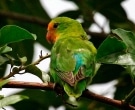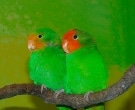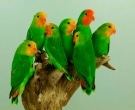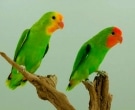Content |
|---|
Description “Red-headed Lovebird”:
Among 13 and 15 cm in length and a weight between 29 and 50 g..
The Red-headed Lovebird (Agapornis pullarius) has the forecrown, the front of the crown and lores bright orange red; the back of the crown, nape, the mantle and scapulars bright green; rump bright light blue; uppertail-coverts They are bright green; undertail They are yellowish green. Upper, the wing-coverts they are bright green and gives the impression of being in relief; small area of ​​clear bright blue in the carpal joints. The primaries and secondaries Green in them vane external and blackish at the internal. Under, the wing-coverts they are black, underside of flight feather blackish. The chin and throat They are bright orange-red; rest of the underparts bright green (paler than the upper region). Central feathers of the tail green, the green side marked red and with a black subterminal band, yellow (or yellowish green) at the tips.
Bill red. The eye ring It is formed by a thin and small band of blue and white feathers; irises dark brown; legs gray or greenish gray.
The female of the Red-headed Lovebird has the head, the chin and throat with yellowish orange edges in the back. Under, the wing-coverts green.
The immature they are like the adult female, but the orange color head and throat It is yellower. Young males shows the black color wing-coverts undertail. The bill is reddish brown.
- Sound of the Red-headed Lovebird.
Description 2 subspecies:
-
Agapornis pullarius pullarius
(Linnaeus, 1758) – The nominal species
-
Agapornis pullarius ugandae
(Neumann, 1908) – Possibly you have blue color rump a shade lighter than the nominal species.
Habitat:
The Red-headed Lovebird They inhabit humid lowland savannahs., isolated patches of forests into savannas, Riverine forests, shrublands, and more open habitats, including abandoned plantations, cropland and pasture.
They prefer secondary forests and primary education, only in the vicinity of grassy clearings.
Usually live below 1.500 m altitude, until 2.000 metres in Uganda.
Shapes flocks of up to 30 birds, wandering in search of food and returning at sunset to their communal roost favorite.
In captivity, often they sleep hanging upside down.
Reproduction “Red-headed Lovebird”:
The Red-headed Lovebird are single birds with respect to the breeding. They build their nest in a tree cavity (generally excavated by a Woody Woodpecker), in some hole dug by arboreal ants or occasionally termiteros terrestre.
The nest It is a bed of hulls and shredded leaves, perhaps hardened excrement. The female, apparently, It is responsible for its construction.
The breeding season It covers the rainy season, when grass sowing is done. The laying compose from 3-6 eggs (sometimes more in captivity).
The chicks hatch without down.
Food “Red-headed Lovebird”:
The diet Red-headed Lovebird It is mainly composed of grass seeds, including cultivars (millet and sorghum).
They also feed, occasionally, of fruit (Psidium and Ficus).
Considered as plague serious of crops in some areas.
Distribution:
Size of the area of distribution (reproduction / resident): 8.360.000 km2
The Red-headed Lovebird They are widely distributed, but erratically through West Africa and central. There are records Guinea, North of Sierra Leone and North of Ivory Coast in the region of Boundiali and Tingrela; in Ghana, found in the north and east of the country, south and west around Acra. They are also observed in southern Togo and Benin and in parts of central and southern Nigeria, but apparently absent from the coastal regions.
The islands gulf of guinea (in prince island extinct). Irregularly distributed through Cameroon to the South of Cabinda and Northwest of Angola (possibly south to the cuanza river) and of the Central African Republic and southern end of Chad to the South of Sudan and North of Democratic Republic of the Congo; in Uganda and registered at the west end of Kenya, and Northwest of Tanzania.
Burundi and Rwanda. There is a seemingly isolated population in southwest Ethiopia.
Usually sedentary although some local migrations and nomadism have been recorded (for example, Nigeria, Uganda and Tanzania).
Its abundance varies widely: common in some areas (for example, flood plains Niger, Nigeria and Brazzaville, Republic of Congo), but only locally abundant (for example, Ethiopia):. Uncommon in many other areas (e.g Angola, South of Ghana – where apparently it is almost extinct – and West Kenya ). Its population also varies due to nomadic habits., but a true overall decline appears to have occurred in many areas in this century. Caught for the trade in live birds with large numbers in captive outside the range.
Subspecies distribution:
-
Agapornis pullarius pullarius
(Linnaeus, 1758) – The nominal species
-
Agapornis pullarius ugandae
(Neumann, 1908) – Ethiopia, Uganda, is of Democratic Republic of the Congo, Rwanda, West of Kenya and Tanzania
Conservation:
• Current Red List of UICN: Least concern
• Population trend: Decreasing
The size of the world population It has not been quantified, but the species, according to sources, in general it is quite rare and never reported as abundant, except locally on Ethiopia (pit et to the. 1997).
The population of the Red-headed Lovebird It is suspected that it may be in decline due to ongoing habitat destruction and unsustainable levels of exploitation.
The “Red-headed Lovebird” in captivity:
Quite common to 1960, since then rarely available and difficult to find specimens that are not imported due to the difficulty of breeding them in captivity.
The Red-headed LovebirdLovebirds.
The Red-headed Lovebird they are birds calm and harmless; initially shy and huidizos; They can easily hit when excited; newly imported birds are susceptible; keep in small cages at first and place it in a quiet place; regularly manage complex with vitamina C; are not big chewers; in communal aviaries only species pinzones, because they can not compete with other species Lovebirds; changing diet or the establishment, only when absolutely necessary, to They are not very adaptable; immature susceptible to 10 months, after they are more resistant.
Being a bird with little success in breeding, no mutations are known about him.
With regard to its longevity, according to sources, a specimen lived for 18 years in captivity.
Alternative names:
– Red-headed Lovebird, Red headed Lovebird, Red-faced Lovebird (English).
– Inséparable à tête rouge, Inséparable à face rouge, Inséparable pullaria (French).
– Orangeköpfchen, Unzertrennlicher (German).
– Inseparavel de cabeca vermelha, Inseparavel-de-cabeca-vermelha (Portuguese).
– Inseparable Carirrojo, Inseparable de Cabeza Roja, Agapornis Pullaria (español).
scientific classification:

– Order: Psittaciformes
– Family: Psittaculidae
– Genus: Lovebirds
– Scientific name: Agapornis pullarius
– Citation: (Linnaeus, 1758)
– Protonimo: Psittacus pullarius
Images “Red-headed Lovebird”:
Videos "Red-headed Lovebird"
“Red-headed Lovebird” (Agapornis pullarius)
Sources:
– Avibase
– Parrots of the World – Forshaw Joseph M
– Parrots A Guide to the Parrots of the World – Tony Juniper & Mike Parr
– Birdlife
– Photos:
(1) – photo sent by Federico Antonio Herd Misantone – Agapornis.it
(2) – By H.v.d.Hoek. – gosenbenjamins.nl
(3) – 10 four young birds breeding pairs By HvdHoek. – gosenbenjamins.nl
(4) – MiAgapornis
(5) – female by ConservationIsGreat – Lynx
(6) – Agapornis pullarius (Red-headed lovebird) by John Gerrard Keulemans [Public domain], via Wikimedia Commons
– Sounds: selvino (Xeno-canto)








Hello, good afternoon, I was wondering if anyone knows someone who sells lovebirds pullarius, I hope your answer soon, thank you very much.
Hello,
I have been breeding since 2004 Pullaria. Have 4 ZP and looking for contact to breeders.
MfG
Without a doubt, an Agapornis that is very difficult to breed and requires super special care.. In Europe it there is little 5 breeders that have. Greetings